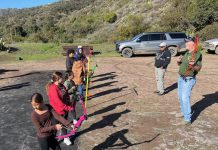THIS WEEK: WHAT’S IN A NAME?
Editor’s Note: Jim Watson is the author of “Mysterious Island: Catalina,” available at Amazon, Kindle and in stores in Avalon.
Have you ever been to Fat City?
Well, if you’ve ever been to Manteca, California, then you have indeed been there since the word “manteca” in Spanish literally means “lard.” Check it out the next time you’re in the meat section at Vons, where they sell little bricks of it.
THIS WEEK: WHAT’S IN A NAME?
Editor’s Note: Jim Watson is the author of “Mysterious Island: Catalina,” available at Amazon, Kindle and in stores in Avalon.
Have you ever been to Fat City?
Well, if you’ve ever been to Manteca, California, then you have indeed been there since the word “manteca” in Spanish literally means “lard.” Check it out the next time you’re in the meat section at Vons, where they sell little bricks of it.
Then there’s “Ash Tree” (Fresno), “Reindeer” (Reno) and Cerritos (“little hills”). And who could forget Las Vegas, which literally translates to “the meadows.” Go figure that one.
The study of place names is a fascinating sub-genre in the discipline of Geography and the American West is loaded with interesting specimens, the majority, of course, being Spanish words.
Here on Catalina we have a number of both Spanish and English place names for those locales that we all hold near and dear. I shall forthwith attempt to “learn you” some of the stories behind a random selection of them.
As far as the basics are concerned, I like to think that most of us who live here know that the Island was named after Saint Catherine of Alexandria and that the town of Avalon is named for a pseudo-mythical island that Lord Tennyson addresses in “Idylls of the King.”
Tennyson himself grabbed the reference from Monmouth’s “Historia Regum Britanniae,” which describes Avalon as the place where King Arthur’s legendary sword Excalibur was forged and where the King himself was taken to recover from his wounds following the Battle of Camlann. OK, so maybe you didn’t know all that.
It should be noted here that Avalon has gone under different names in the past, including Timm’s Landing, named for early squatter and fisherman Augustus Timms. Before that, the area was named Dakin Bay, a moniker that appeared on nautical charts for nearly 60 years.
The name “Bay of Moons,” supposedly a translation of an original Tongva name, is largely believed to be an Anglo invention, probably attributable to Charles Frederick Holder. While the name sounds romantic to our modern ears, in reality the Tongva and Native Americans in general tend to be much more practical in their place naming.
Since the original Tongva name for Avalon has been lost to us I’m speculating here, but the original name probably translated to something like “the bay with good fishing” or “the bay in the canyon with year-around water” or something similar.
Some of our local place names are obvious. No one has to explain how Emerald Bay got its name to anyone who has had the pleasure of being there on a sunny summer day. And the etymology behind “Pebbly Beach” needs no explanation whether you’ve been there or not.
Descanso Bay is perhaps the most appropriately named spot on the Island. The Spanish word “descanso” means “rest” or “relax.” So when you are at Descanso Beach “with a drink in your hand and your feet in the sand” you are partaking of a “descanso” at Descanso.
Ben Weston Beach, that local favorite, was named for Benjamin Stone Weston. Contrary to many historical accounts, Weston was not a simple squatter but was in fact a successful sailor turned rancher. (There’s a myth floating around out there that Ben Weston was an Army officer stationed at nearby Camp Cactus during World War II. Don’t pay any attention to it).
Born in Salem, Mass., in 1832, Weston was crewing on a merchant ship trading between the Hawaiian Islands and the West Coast when, one fine day, his ship visited Catalina. Like it was for many of us, the love affair began immediately.
For the righteous sum of 20 bucks worth of gold, Weston purchased sheep ranching rights from then-owner James Lick. After eventually moving his sheep to the Torrance area, Weston spent most of his the rest of his life on the mainland. He passed away in 1905 at the age of 73 and is buried at the Wilmington Cemetery.
Some more of our Spanish place names and their meanings include Salta Verde (“green waterfall,” no doubt a reference to the seasonal waterfall in Silver Canyon), “Palisades” translates to “cliffs” and “Rancho Escondido” literally means “hidden ranch.” The ranch earned the adjective “hidden” because Mr. Wrigley’s original surveyors, returning on their second trip to the spot of the future ranch, had a heck of a time finding the place.
I purposely saved the most mysterious, if you will, Catalina Island place name for last. At 2,125 feet, Mt. Orizaba is the highest peak on Catalina. While the mountain itself stands out auspiciously, the origins of the name “orizaba” are somewhat obscure.
I should say here that there’s nothing mysterious about the actual act of naming the mountain. It was dubbed thusly by Sebastian Vizcaino on his voyage to the West Coast in 1602. But the etymology of the word “orizaba” is debatable.
Vizcaino most likely named the mountain after a volcano of the same name in the southern Mexican state of Veracruz. The “Pico de Orizaba” dominates the Orizaba Valley near the town of—you guessed it—Orizaba, Veracruz.
The word “orizaba” is thought to be a rough—very rough—corruption of the Aztec word “Ahuilizapan,” which means “valley of happy waters.”
That sounds like a bit of a stretch to me, but there is another possibility. Because the Arab-speaking Moors dominated Spain for many centuries, the Arabic language had a profound influence on the Spanish language. Yes, the Spanish spoken here in California has sizeable chunks of Arabic in it, much like English has echoes of Latin and French.
If you take the common Spanish place name “jerez” (a derivative of the Arabic word “ariz”) and add the Arabic suffix “aba” to that (meaning a “fortification”) you get “Arizaba.” That sounds much more palatable to me.
There are many other intriguing place names on Catalina and I could go on and on, but you have to get back to work. Maybe this can be a topic we take up from time to time.










